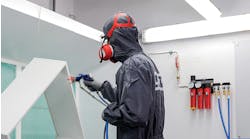The heavy duty collision repair industry is going through several evolutionary changes that are being driven by four key factors:
- Technological advances in heavy duty vehicle design and manufacturing.
- Increasing demand for accurate measurement and documentation of vehicle damage.
- The desire to improve shop productivity, increase cycle times and minimize vehicle downtime.
- Efforts to increase technician safety.
TECHNOLOGICAL ADVANCES
Heavy duty truck manufacturers have introduced a wide range of new technologies in recent years, with many more under development. Federal greenhouse gas (GHG) emissions and fuel efficiency standards for medium and heavy duty vehicles have led OEMs to develop new pollution control equipment and to incorporate increasing amounts of newer materials like aluminum and high-strength steel into their vehicle designs. As a result, the heavy duty collision repair industry needs to invest in new repair methods, training and equipment in order to make proper collision repairs.
Looking ahead, another technology challenge for the industry will be dealing with the broad spectrum of new sensors under development to provide driver assistance and increase vehicle safety. Advanced control systems that rely on sensors to detect surroundings are already being implemented in passenger vehicles and commercial trucks for adaptive driving, emergency-braking control and lane-changing/blind-spot notification. Repairing a vehicle’s structure and properly locating these sensor systems will require the use of a measuring system that delivers millimeter precision.
ACCURATE MEASUREMENT AND DOCUMENTATION
In most heavy duty shops, vehicle measuring is still conducted with centerline gauges and string, a method that, while accurate when performed correctly, is limited in scope and is time consuming. Plus, “documentation” consists of just whatever the technician writes down.
While light duty shops began transitioning to the accuracy of computerized measuring system decades ago, the move on the heavy duty side has been hampered by the specialized nature of Class 8 trucks. It’s nearly impossible to have spec data for every single truck on the road. But new technology lets shops more accurately measure and document collision damage on trucks and trailers using 3-D stereo photogrammetry (the science of making measurements from photographs, such as for maps).
For example, Chief’s new Cam Scan HD measuring system lets technicians easily measure and compare two points anywhere on a vehicle. It can measure the condition of a frame in X, Y and Z axes to detect diamond, mash, sway and twist.
Systems like this can be used for frame rail analysis, axle and trailer alignment analysis, and even to measure areas that the centerline gauge and string method can’t, such as upper body damage and cab openings. Computerized measuring systems allow technicians to see and document the full scope of the damage, develop a plan for repairs, and then print out professional, documented proof of the repairs.
Insurance companies are increasingly demanding documentation of vehicle damage and proper repairs. This includes documentation showing all of the damage in order to approve an estimate for repair, as well as documentation demonstrating that the repairs were made prior to initiating payment.
This same documentation is vital to the repair shop for two other important reasons. First, repair documents provide peace of mind to the customer and instill confidence in the shop’s professional abilities. Second, from a liability standpoint, repair documentation provides proof as to the exact condition of the truck when it entered and left the shop.
Printed, verifiable repair documents are an important part of today’s shop function that will only grow more critical in the future.
IMPROVED SHOP PRODUCTIVITY
There is always a good deal of pressure on a shop to get a truck back on the road as quickly as possible. But squaring up a trailer that has rolled or repairing a cab that is manufactured with a mix of steel, aluminum and other materials can be tricky when relying on traditional repair tools and methods. Investing in a couple key pieces of new equipment can help shops improve productivity during repairs like these.
Start at the foundation: fixing the frame. For years, technicians needing to push or pull out damage to a heavy duty vehicle frame have had to hand-build a frame-correction system before getting to work. This type of pulling system uses components that weigh up to 150 lbs each, making it quite taxing for technicians to set up. Plus, it can take up to an hour and a half to get the system built, and the truck into position to make a pull.
Drive-on frame racks are a much faster – and less risky – solution than hand-building a pulling system out of heavy pieces of steel every time you need to make a repair. Technicians simply can drive the largest heavy duty vehicles into place, swing the attached towers into position and get to work in as little as 10 minutes.
Some drive-on racks offer additional labor- and time-saving advantages. For example, the Centurion rack from Chief has hydraulic towers that easily move independently to allow true 360-degree pulling. To speed prep time, the deck of the Centurion is pre-plumbed with air, controls and hydraulic outlets every 10 feet.
As each hydraulic tower is rolled into position, it is easily plugged in and ready to go to work. This feature also keeps the floor clean and free of trip hazards. Tower adjustments to position for the correct pull are non-strenuous thanks to the lightweight aluminum rollers located in each tower.
Just like the automotive OEMs, truck manufacturers are using an increasingly diverse mix of materials and joining methods to build their cabs. Gone are the days of a mild steel cab that can be easily welded back together. New cabs are made of aluminum, carbon fiber and high-strength steels that may require sectioning, riveting or welding to repair.
It’s crucial to have the right equipment to make the proper repairs to these vehicles. Your old welder or even a new rivet gun may not be powerful enough or have the right specifications for the job at hand.
In some cases, equipment manufacturers have to innovate right alongside the truck manufacturers. For example, OEMs are using more structural adhesives in the manufacturing process, such as to strengthen the bond between a cab fender and hood. Removing this adhesive can be difficult. Many shops use an open flame to try to heat up the adhesive and separate the panels. Others resort to driving a chisel between panels.
Both methods carry great risk of damage to the vehicle – and the technician. Chief has introduced a product specifically designed to swiftly break the bond of structural adhesives without damaging the surface above or below the glue. The Vulcan ADU uses infrared radiation technology to quickly heat the vehicle surface to a temperature where the first layer of glue underneath releases cleanly. With the adhesive bonds broken, the technician can then easily separate the materials. Talk to your local collision repair equipment distributor to learn what’s new – you may be surprised to learn how much faster and easier your job could be.
INCREASED TECHNICIAN SAFETY
Shops are looking for ways to reduce potential technician injuries by eliminating the need to lift heavy equipment and components. One sure-fire method is to move from hand-built pulling systems to drive-on frame racks. Shop equipment manufacturers are also developing tools with features designed to help reduce technician strain and fatigue – like the boom that’s available with Chief’s Heavy Duty Rivet Gun to take some of the tool’s weight off the technician’s hands.
Shops are also exploring how to create a safer work environment by adding fume extractors and dust extractors to prevent technicians from breathing harmful airborne particulates created when welding and sanding.
THE FUTURE
The future of heavy duty collision repair will center on working with new technologies and advanced materials incorporated into the vehicles themselves, as well as the technological advances of the tools required to repair them. This will increase both shop productivity and technician safety.
Lee Daugherty is the heavy duty sales manager for Chief Automotive (www.chiefautomotive.com). The company offers an extensive line of collision repair equipment, operates Chief University, a collision repair school that provides the most up-to-date training.




